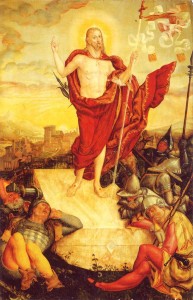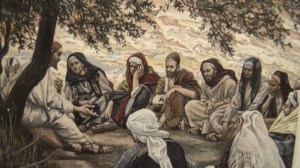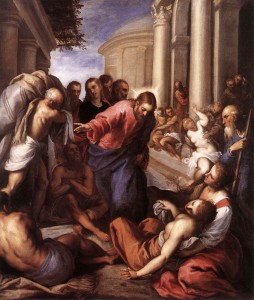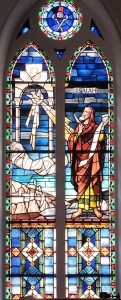Passion Predictions
by Paul Zilonka, C.P.
Our study addresses several key elements of the so-called predictions of the passion, which are principally found in the synoptic Gospel tradition. These basic elements include: public conflict in the ministry of Jesus; the role of the predictions in the synoptic Gospels in relation to the suffering, death and resurrection of Jesus; their relationship to the call of discipleship in the synoptic tradition; the existence of other predictions of the passion outside of the synoptic tradition, particularly the distinct Johannine presentation of the “lifting up” of Jesus; the possible influence of the Old Testament on the passion predictions; and the historicity of the passion predictions.
Public Conflict in the Ministry of Jesus
All four Gospels contain references to animosity toward Jesus in the course of his ministry, though this conflict is generally confined to verbal disagreements about interpretation of the Mosaic Law and religious practice. For example, Jesus observed the tradition of synagogue worship on the Sabbath (Luke 4:16). However, many of the healings performed by Jesus occur on the Sabbath, thus highlighting Jesus’ appeal to a different tradition of Sabbath than the strict Sabbath regulations favoring a “rest from labor” inspired by the Genesis account of creation. In Genesis 2:2, God is said to have rested from his labor. Diverse sects of Judaism in the time of Jesus, such as the Pharisees and the stricter Essenes, considered this text normative for their own behavior and made lists of prohibited types of activities on the Sabbath.
On the contrary, Jesus’ actions of healing on that holy day seem more inspired by the Deuteronomic tradition which thinks of the Sabbath in terms of the liberation of God’s people from Egyptian slavery (Deut. 5:15). In his Sabbath miracles, Jesus freed men and women from the burdens of physical illness, like the “daughter of Abraham whom Satan bound for eighteen years” (Luke 13:16).
His exorcisms had aroused accusations of sorcery even though he was attacking the reign of Satan as he acted by the Spirit of God (Matthew 12:24-26; Mark 3:22-26; Luke 11:5-18). The anticipation of conflict of a more violent nature also comes into the thoughts and words of Jesus principally in the synoptic Gospels in a literal fashion, but also in the Johannine tradition in a veiled way. Thus, all four Gospels portray Jesus referring to conflict in a future time when others will take certain aggressive actions against him, culminating in his death. Like many people who know of enemies who have strong feelings against them, Jesus may well have had quite natural premonitions of impending harm or even assassination. Death threats are not so uncommon in every age when one person with power considers another person troublesome or an obstacle to one’s own welfare.
However, these references to his future suffering and violent death in the Gospels of Matthew, Mark and Luke also include something unique, namely, the clear statement that he would be raised from the dead. The inclusion of this unexpected element means that it would be more accurate to speak of these texts as “passion and resurrection” predictions. This distinctive addition joined to the mention of suffering and death convinces many scholars that the historical veracity of the predictions in general is suspect. They suggest that, in the evangelists’ presentation of these passion and resurrection predictions, we encounter a variety of elements which may voice accurately some thoughts or words from the historical ministry of Jesus, but may also reflect the subsequent profession of faith in Jesus by the early Church after his resurrection. This historical evaluation is best discussed after more thorough familiarity with the texts themselves.
Role of the Predictions in the Synoptic Gospels
The so-called “passion predictions” occur principally in the synoptic Gospels and reveal some strong interrelationships in some details, something that is not always true in other texts common to Matthew, Mark and Luke, apart from some triple tradition parables and brief narratives. For the sake of convenience, and following the current scholarly preference for Mark as the first of the Gospels, we will focus upon the predictions as we find them in Mark (8:31; 9:31; 10:33-34). We will note some significant variations in the Matthean and Lukan parallels (Matthew 16:21; 17:22-23; 21:18-19; Luke 9:22; 9:43b-44; 18:31-33). Jesus makes other references to future events at Jerusalem in Mark 9:9,12; 14:8, 17-25, 41-42. However, in Mark, the three principal passion predictions appear to bear a significant relationship to the broader structure of Mark in the journey section from Caesarea Philippi in 8:27 to the arrival at Jerusalem in 11:1.[i]
The Gospel of Mark runs for sixteen chapters and presently ends at 16:8. Scholars vary in their opinions about any additional verses or chapters, which have been added over the centuries, but are not extant in the earliest manuscripts. The first eight chapters in Mark provide some teachings of Jesus about the kingdom of God, and include many stories of healing and exorcism. This first portion of Mark appears to culminate with the inquiry which Jesus makes of his closest disciples about his identity. After they mention some popular notions associating Jesus with earlier prophetic figures, Peter proclaims for the first time in this Gospel the title, which will become synonymous with Jesus’ own name eventually. “You are the Messiah” (8:29). At this point, the story takes a sharp turn geographically from Caesarea Philippi in the far northern section of Galilee southward toward Capernaum where Jesus lived during the years of his ministry, and subsequently onward to Jerusalem in Judea where Jesus will die.
The passion predictions lie in this second half of Mark when enmity has arisen against Jesus in Galilee. In the chapters following Peter’s affirmation, indications of impending suffering for Jesus are coupled with the sober tone of his teaching about discipleship. Indeed, the three Markan passion predictions show a certain interlocking quality with three admonitions to Jesus’ disciples (8:34-9:1; 9:33-37; 10:35-45). All of this prepares the reader/listener to expect some sort of grave danger as Jesus arrives at Jerusalem, which he visits only once in Mark, Matthew and Luke.
For the first prediction, the evangelist writes: “Then he began to teach them that the Son of Man must undergo great suffering, and be rejected by the elders, the chief priests and the scribes, and be killed, and after three days rise again” (8:31). We note the characteristic use of the title “Son of Man” which Jesus often uses in place of “I.” Though this third person reference to himself might seem odd to us, it is meant to direct the early community’s attention and ours to another biblical figure with whom Jesus associates his own fate. The “suffering” mentioned here is hardly specific. Jesus has already experienced conflict with some Jewish teachers and scribes in Galilee, especially for his miraculous healings on the Sabbath, and his exorcisms which could lead to a penalty of stoning, at least according to the ruling of m. Sanhedrin 7:4 which was transcribed at a later time.[ii]
The attribution of guilt to the Jewish leadership is present in all three versions of the first prediction, but will become more complicated as the story moves along. The method of killing Jesus is not specified at this time though “crucify” and “cross” occur later in Mark no less than nine times in the passion narrative (15:13, 14, 15, 20, 21, 24, 25, 27, 30). Likewise, there will be a summons to disciples to take up their “cross” in the immediate context of the first prediction at 8:34. This would imply Jesus also would be crucified.
The variations in the final clause regarding resurrection evoke much reflection. Each time, Mark will have Jesus say “after three days” while Matthew and Luke consistently say “on the third day”. To scholars, it appears evident that the less precise “after three days” found in Mark has been influenced by the resurrection tradition “on the third day” (1 Corinthians 15:4).
A similar pattern of variation is evident in that Mark consistently puts the verb in the active voice, namely “he will rise again,” while Matthew prefers a passive form “he will be raised.” Luke goes his own way and uses both forms. “Matthew’s ‘he will be raised’ may also reflect a more theologically careful affirmation that Jesus was raised by God – reflecting the regular confessional formula of the early years of expansion.” [iii]
The second prediction in Mark strikes us as even simpler in detail. “The Son of Man is to be betrayed into human hands, and they will kill him, and three days after being killed, he will rise again” (9:31). There is no mention of the identity of the agents who will take aggressive action against Jesus. Rudolph Pesch argues that the predictions are part of a pre-Markan passion narrative. In that case, the “human hands” here would refer to the Jewish people.[iv] The end result, however, is the same. He will be killed, and he will rise after three days. Luke offers a significant variation here in that Jesus only says that “the Son of Man is going to be betrayed into human hands” (Luke 9:44). This simplest prediction in Luke indicates the range of detail among the variant versions of the predictions from its brevity to the elaboration present in the third predictions (Mark 10:33-34; Matt 20:18-19; Luke 18:31-33).
 The third Markan prediction practically serves as an outline of the last hours of Jesus, which will be described at greater length in the passion narrative proper. “See we are going up to Jerusalem, and the Son of Man will be handed over to the chief priests and the scribes, and they will condemn him to death; then they will hand him over to the Gentiles; they will mock him, and spit upon him, and flog him and kill him; and after three days he will rise again” (10:33-34).
The third Markan prediction practically serves as an outline of the last hours of Jesus, which will be described at greater length in the passion narrative proper. “See we are going up to Jerusalem, and the Son of Man will be handed over to the chief priests and the scribes, and they will condemn him to death; then they will hand him over to the Gentiles; they will mock him, and spit upon him, and flog him and kill him; and after three days he will rise again” (10:33-34).
Noteworthy here is the addition of Gentiles as collaborators in the execution of Jesus. This accurately reflects the political situation which prevailed in Jerusalem at the time of Jesus’ condemnation and death. Since Rome had taken over this eastern part of the Mediterranean basin in 63 BC, successive Jewish leaders served with the permission of Rome. With the death of Herod the Great in 4 BC, Palestine was divided among his sons, but by AD 6 Judea was directly under the provenance of Roman procurators. Thus, the reference to “the Gentiles” in this third prediction actually refers to Pontius Pilate who held office from AD 26 to AD 36. His legions would likewise be implied in the degrading actions spelled out in the prediction. While the Sanhedrin of the Jewish leadership held certain authority to manage local affairs, it seems well founded historically that capital punishment, even for Jews, was reserved to Roman authority. In fact, in all four passion narratives, the charges brought against Jesus in the trial before Pilate allude to the alleged political danger he presented, rather than the accusations of blasphemy or other intra-Jewish disputes which the same Gospels associate with the Jewish interrogations of Jesus.
In this third prediction in Mark and Luke, there is still no specific description of the instrument with which Jesus will be killed, but with mention of the Romans as executioners, the possibility of crucifixion comes into play. Thus, it is not surprising that Matthew’s version specifically mentions that mode of execution (Matthew 20:19). The Romans used crucifixion frequently during their subjugation of ancient Palestine, particularly against any Jews judged to be seditious against Roman authority. Josephus recounts many mass crucifixions in Judea (Antiquities 11, 261, 266. 267; 17, 295; 20, 102.129; War 5:449-451). Jesus was no stranger to this history in his land.
The Predictions and the Call to Discipleship
The Gospel of Mark has a partiality for linking texts which shows itself here. When Peter objects to Jesus’ dire foreboding in the first passion prediction (8:31), Jesus rebukes him for his reliance on purely human judgment. “Get behind me, Satan! For you are setting your mind not on divine things but on human things” (8:33). Then, Jesus launches into the first of three admonitions successively associated with each of the three predictions. All three clearly suggest that authentic disciples will necessarily find themselves in some way closely aligned with the fate of the crucified Jesus.
 For the first time in the gospel story we call Mark, there is mention of a “cross.” However, it is not the cross of Jesus. Rather, Jesus says: “If any want to become my followers, let them deny themselves and take up their cross and follow me” (8:34) This sobering text, which implies martyrdom for the disciples of Jesus, hints, without saying explicitly, that Jesus also will have borne a cross ahead of them. We will not hear of Jesus’ cross until the Roman governor, Pontius Pilate, condemns him to be scourged and crucified. Jesus continues to address his close disciples. “For those who want to save their life will lose it, and those who lose their life for my sake, and for the sake of the gospel will save it” (8:35) The disciples may lose their lives on this earth, but from the perspective of the ironic wisdom so characteristic of Jesus’ whole ministry, they are actually saving their lives.
For the first time in the gospel story we call Mark, there is mention of a “cross.” However, it is not the cross of Jesus. Rather, Jesus says: “If any want to become my followers, let them deny themselves and take up their cross and follow me” (8:34) This sobering text, which implies martyrdom for the disciples of Jesus, hints, without saying explicitly, that Jesus also will have borne a cross ahead of them. We will not hear of Jesus’ cross until the Roman governor, Pontius Pilate, condemns him to be scourged and crucified. Jesus continues to address his close disciples. “For those who want to save their life will lose it, and those who lose their life for my sake, and for the sake of the gospel will save it” (8:35) The disciples may lose their lives on this earth, but from the perspective of the ironic wisdom so characteristic of Jesus’ whole ministry, they are actually saving their lives.
After the second prediction, the disciples are admonished about their future behavior in the pericope dealing with their discussion about “who was the greatest” (9:34). Jesus then gave the Twelve a lesson about service. “Whoever wants to be first must be last of all and servant of all” (9:35). Jesus emphasizes his point of service by embracing a child in their midst. “Whoever welcomes one such child in my name welcomes me, and whoever welcomes me welcomes not me but the one who sent me” (9:37). Even today, children are often overlooked or mistreated. By choosing someone in his society who would not have immediately received serious attention from the adult disciples, Jesus dramatizes the scope of an authentic disciple’s readiness to die to oneself. In the light of the second prediction and the subsequent reality of Jesus’ own humiliation, his admonition and imaginative gesture effectively rebukes their merely human ambitions.
The third prediction in Mark comes in the chapter immediately preceding the entrance of Jesus into Jerusalem. Its details prepare the reader/listener more explicitly to understand the ominous cloud hanging over this “last week” of Jesus’ life. As in the case of the other two predictions, Mark’s text of the third prediction presents an occasion for Jesus to rebuke misbehavior on the part of the Twelve. James and John seek special privilege when Jesus achieves glory. They are presented by the evangelist as still perceiving his mission in merely human terms associated with worldly power and gain. Jesus uses the occasion to assess their readiness to die with him. “Are you able to drink the cup that I drink, or be baptized with the baptism that I am baptized with?” (10:38)
They said to him, “We are able.” Jesus said to them, “The cup that I drink, you will drink; and with the baptism with which I am baptized, you will be baptized; but to sit at my right hand or at my left is not mine to grant, but it is for those for whom it has been prepared” (10:39). When the other ten disciples heard this, they became indignant at James and John. Jesus summoned them and said to them, “You know that among the Gentiles those whom they recognize as their rulers over the Gentiles lord it over them, and their great ones are tyrants over them. But it is not so among you; but whoever wishes to become great among you must be your servant, and whoever wishes to be first among you must be slave of all. For the Son of Man came not to be served but to serve, and to give his life a ransom for many” (10:42-45).
Despite many differences between Mark, Matthew and Luke, the parallels of the predictions found in Matthew and Luke and in the associated admonitions on true discipleship reveal a consciousness of the relationship between Jesus’ death and faithful discipleship. Matthew and Luke add significant amounts of traditional material, which make their Gospels relatively twice as long as Mark. However, this Markan section of passion predictions, sacrificial admonitions to the disciples, and the closing statement on the service rendered by the Son of Man exhibits a significant degree of unity throughout all three synoptics.
The Distinctive Johannine Presentation of the Predictions
The synoptic predictions have an explicitly physical quality in their descriptions of future sufferings that await Jesus. In this regard, they are quite unlike what appear to be equivalent sayings in the Gospel of John, which describe Jesus being “lifted up” (3:14; 8:28: 12:32). At first glance, these brief sayings in John have almost nothing in common with the synoptic predictions, but both the synoptic and the Johannine predictions take into account the death and the resurrection of Jesus. However, in the Johannine presentation, the note of triumph prevails. “It would not be an overstatement to say that in the synoptic gospels Jesus’ path takes him through suffering and death to glory, whereas in the fourth gospel it leads him to something which is suffering, death and glory simultaneously…Passion and action are spoken of by the same word; defeat and victory, suffering and glory are particularly together” [v]
 This same sense of certitude about the ultimate victory of Jesus over death may account for restraint in the description of the physical sufferings of Jesus later in John’s narrative of the passion itself. Physical suffering does not receive the descriptive attention there which it receives in the synoptic passion narratives. “Having loved his own who were in the world, he loved them to the end” (John 13:2). This Johannine vision of the self-emptying of Jesus reflects maturity in theological insight and expression, which has moved beyond the need to highlight the physical aspects of the suffering of Christ. The whole scene of Calvary in John has been presented as one of triumph and exaltation rather than degradation and sadness. The Romans physically lift up Jesus on the cross, it is true, but this gesture of humiliation and torture is now proclaimed in the Gospel narrative as an exaltation rite enthroning Jesus as king of all the nations.
This same sense of certitude about the ultimate victory of Jesus over death may account for restraint in the description of the physical sufferings of Jesus later in John’s narrative of the passion itself. Physical suffering does not receive the descriptive attention there which it receives in the synoptic passion narratives. “Having loved his own who were in the world, he loved them to the end” (John 13:2). This Johannine vision of the self-emptying of Jesus reflects maturity in theological insight and expression, which has moved beyond the need to highlight the physical aspects of the suffering of Christ. The whole scene of Calvary in John has been presented as one of triumph and exaltation rather than degradation and sadness. The Romans physically lift up Jesus on the cross, it is true, but this gesture of humiliation and torture is now proclaimed in the Gospel narrative as an exaltation rite enthroning Jesus as king of all the nations.
The synoptic predictions are closely linked, almost as echoes of one another with slight variations of detail. In the case of John, the linkage which scholars propose is principally based on the shared use of the verb “to lift up” (hypsoun). Though its primary meaning pertains to lifting some object physically, its secondary figurative meaning pertains to enhancement in honor, fame, power or fortune (Luke 1:52; Matthew 23:12b; Luke 14:11b; Luke 18:14b; 1 Peter 5:6). [vi] Additionally, the underlying Hebrew term carries both meanings of death and glorification as is seen when the imprisoned Joseph interprets the dreams of Pharaoh’s cupbearer and his baker whose subsequent fates are completely opposite when they are “lifted up” (Genesis 40:1-23, esp. 13 and 19).
“There is no reason to think the Fourth Evangelist is dependent on the synoptics for his form of the sayings; indeed, on a comparative basis the Johannine sayings are far less detailed and could be more ancient. The chief influence on the Johannine sayings seems to be the theme of the Suffering Servant (Isaiah liii 13); ‘Behold my servant shall prosper: he shall be lifted up (hypsoun) and glorified exceedingly.’ The statement that the son of Man must be lifted up reflects the theme that his being lifted up was predicted in Scripture (especially Isaiah lii-liii) and thus was part of God’s will.” [vii]
The first “lifting up” text in John strikes a positive tone with clear relationship to a significant story of healing from the book of Numbers (21:9) “And just as Moses lifted up the serpent in the wilderness, so must the Son of Man be lifted up, that whoever believes in him may have eternal life” (3:14-15). This initial text immediately leads into John’s bold statement summarizing the mission of the Word made flesh. “For God so loved the world that he gave his only Son, so that everyone who believes in him may not perish but may have eternal life” (3:16).
Ordinarily the Gospel of John refers to Jesus as “Son.” However, just as Jesus refers to himself as “the Son of Man” in the synoptic passion predictions, he does the same here. Likewise, when comparing John 3:14 and Mark 8:31, we discover that both texts contain the “must” which scholars call the divine imperative and which affirms that this process of death and resurrection is the will of God. Thus, we read in John 3:14: “So must the Son of Man be lifted up.” Compare this with Mark 8:31 “The Son of Man must undergo great suffering…be killed, and after three days rise again.” The synoptic passion predictions always include reference to resurrection. The similarity between those sayings and this language of John is one reason for insisting that “to be lifted up” in John includes more than the crucifixion.
In the story in Numbers 21, the people of Israel traveling with Moses through the Sinai after release from Egypt murmur against the Lord for which God sends among them serpents whose sting is like fire and threatens their lives. God is always attentive to Moses’ pleading for the people and enables Moses to prepare a remedy to bring healing, with the condition that the injured look at the bronze serpent lifted up on a pole. This act of looking is the means through which God heals them.
The Johannine context suggests that God has sent the Word, his Son, not to heal by magical means or some human intermediary but to bring salvation himself. It is not the people who die, but the Son who will lay down his life for them. He does so by being “lifted up,” as was the image of the serpent on a pole. The healing which transcends physical healing comes when they believe in the one whom they see lifted up. In John, the salvific scene for that small group of people in the Sinai desert has been used to point to the answer to Nicodemus’ question “How can a man be born again once he is old?”
“Begetting through the Spirit can come about only as a result of Jesus’ crucifixion, resurrection, and ascension.” [viii] The broader context of John makes clear that “lifted up” should not be restricted to denoting the physical death of Jesus. For example the same verb (hypsoun) refers to the ascension of Jesus in Acts 2:33 and 5:31. “Thus in John ‘being lifted up’ refers to one continuous action of ascent: Jesus begins his return to his Father as he approaches death (xiii 1) and completes it only with his ascension (xx 17). It is the upward swing of the great pendulum of the Incarnation corresponding to the descent of the Word which became flesh. The first step in the ascent is when Jesus is lifted up on the cross; the second step is when he is raised up from death; the final step is when he lifted up to heaven.” [ix]
The second Johannine text also uses the phrase “Son of Man” but is most distinctive for its use of one of John’s celebrated “I AM” sayings. “When you have lifted up the Son of Man, then you will realize that I am he, and that I do nothing on my own, but I speak these things as the Father instructed me” (8:28). At first, this text seems to bear no specific relation to the suffering of Jesus on the cross of Calvary. However the tone of the text recalls the obedient love of Jesus who elsewhere speaks of himself as sent from the Father on a mission, a mission that he will complete before returning to the Father. While the synoptic Gospels, unlike John, depict the prayer of Jesus in the Garden of Gethsemane on the eve of his death as an agonizing human struggle, both they and John agree in their depiction of Jesus as voluntarily binding himself to carry through on the divine plan by accepting the will of the Father. John’s Gospel does so in another setting. “Now my soul is troubled. And what should I say – ‘Father, save me from this hour’? No, it is for this reason that I have come to this hour. Father, glorify your name” (12:27).
“The wider understanding of “being lifted up” explains a statement in the second Johannine prediction at 8:28: ‘When you lift up the Son of Man, you will realize that I AM.’ The justice of Jesus’ claim to the divine name “I AM” was scarcely evident at the crucifixion; it was recognized only after the resurrection and ascension (xx 28).” [x]
In the third “lifted up” text, Jesus speaks in the first person rather than using the Son of Man. “And I, when I am lifted up from the earth, will draw all people to myself” (12:32). Then the evangelist adds one of his occasional explanatory notes, “He said this to indicate the kind of death he was to die” (12:32-33). Jesus is lifted up in death, but this claim to draw ‘all people’ to himself does not appear to be fulfilled on Calvary. This text also points beyond the moment of suffering to the moment of glory. Yet, Joseph of Arimathea and Nicodemus (John 19:38-42) who previously were hesitant to admit their relationship to Jesus do come forward to bury him honorably, “acting as representatives of the ‘all’ whom Jesus has begun to draw to himself.” [xi]
Possible Influence of the Old Testament on the Passion Predictions
The role of Daniel 7 and parts of Isaiah 52:13-53:12 appear to be the most significant factors relative to what the predictions say and the milieu from which they come. While we cannot be sure of the way in which these Hebrew scriptures may have influenced Jesus in his self-understanding of his fate, we can understand the traces of these texts which now echo in the predictions taken as a whole.
Daniel 7:13 speaks of a heavenly vision in which “one like a human being” comes on the clouds of heaven to the presence of the Ancient One. He then receives dominion, glory and kingship; nations and people of every language serve him. His dominion lasts forever. The phrase translated as ‘human being’ is more literally ‘son of man’, though he is spoken of in a celestial context. The innate ambiguity of Jesus’ use of the term is thus established. As the Gospels suggest, he could certainly have used that term in a general and self-referential way, probably best indicated by a translation such as ‘a man like me’, equivalent to the English ‘one.’ If Daniel 7:13 is indeed the basis for Jesus’ self-identification during his ministry, it could well explain how his use of this ambiguous term (son of man=a human being) could grow in its significance and deeper meaning for the Jesus tradition as years passed and faith in Jesus developed in the light of the scriptures. “Because of the ambiguity of the Aramaic phrase itself, and because Dan 7:13 was an example of the idiom (‘one like a human being’), such an allusion need not have been heard as acclaim to be the manlike figure, but could be taken simply as an allusion to the vindication-following –suffering role which the figure represented for the faithful of Israel.” [xii] Eventually, the simple phrase in Aramaic became a formal title in Greek, and other triumphant texts like Psalm 110 became aligned with the description of the dignity and exaltation of Jesus.
The narratives of the passion in all four Gospels clearly show traces of the literary influence of certain sections of the Old Testament, principally the psalms of the suffering just man (Ps 22, 69) and the latter portion of the four Isaian ‘songs of the servant’ (Is 52:13-53:12). Close study of Psalm 22 discovers a number of points of reference to many aspects of the scene at Calvary. The sole word of Jesus from the cross in Mark and Matthew is a direct citation of the initial verse of Psalm 22. “My God, my God, why have you forsaken me?” Though the synoptics do not present any other direct citation of Psalm 22, the description of Roman soldiers rolling dice for the garments of Jesus after he has been crucified (Mark 15:24) offer us a door of particular insight into the formation of the passion narrative in general. What appears to have been the customary prerogative of the executioners is highlighted in John’s Gospel with a deeper theological significance by way of a citation from Psalm 22:18, “They divide my clothes among themselves, and for my clothing they cast lots.” John 19:24 echoes the synoptic mention of the soldiers dividing some of Jesus’ garments, but the seamless robe catches their attention and they then decide to roll dice for it lest its value be lost by shredding it in pieces. The citation of Psalm 22:18 at this juncture piques our attention about the interrelation of Psalm 22 with other details of the passion narrative.
Given this direct relationship of certain parts of the passion narrative with Old Testament passages which are referred to as somehow being brought to fulfillment in the actions taking place around Jesus and by Jesus, one could see how the transmission of the passion predictions themselves, though outside the passion narrative might have been significantly influenced. Prompted by faith in the resurrection, the events of Jesus’ suffering and death were read and reinterpreted in the light of biblical passages from a prediction-fulfillment mentality.
Historicity of the Predictions
Like every other word of Jesus in the Gospel texts, the passion predictions have been analyzed extensively and then made the subject of theories and counter theories. A principal factor in the discussion concerns those who are unwilling to grant that Jesus spoke of his impending death by virtue of “super-ordinary” powers, something assumed by the evangelists who narrate a series of healings, resuscitations, exorcisms and nature miracles.[xiii] Likewise, some scholars assume that John preserves no authentic saying of Jesus. [xiv] Another factor has to do with whether certain phrases occur in early Christian preaching and a reticence to attribute such language to Jesus despite the fact that Paul mentions that he received certain formulas about the death, burial and resurrection from the earliest disciples (1 Corinthians 15:3-5) [xv]
For some minimalists, the second prediction in Luke 9:43b-44 “The Son of Man is going to be betrayed into human hands” has the air of veracity precisely because it is so general, the kind of remark that would come to mind when any person is aware that his words or actions have raised the ire of more powerful people, no matter how good his intentions. It is precisely the increase of physical detail and, specifically, the role which Rome plays in the description of the third prediction, which makes scholars more hesitant to affirm the historical authenticity of that prediction because it closely mirrors the passion narrative’s version of the actions of the Jewish interrogations, the Roman trial and the scene on Calvary. “It looks as though the third prediction has been elaborated in the light of events, so that the greater precision of its telling might reflect (predict) more accurately what was recalled as actually to have happened.” [xvi]
However, as Dunn goes on to say, these predictions follow a pattern familiar from the transmission of other elements of the Jesus tradition, namely “the likelihood that such a firmly recalled tradition was originally derived from those who heard Jesus saying something memorable. It is no longer possible to tell from the traditions whether Jesus spoke on the subject more than once: the threefold sequence looks as though it is part of a much fuller story of Jesus as the shadow of the cross begins to loom ever larger for the story-teller.” [xvii] The threefold sequence in John may also reflect the same phenomenon of a longer story, which was established very early. [xviii]
 Of course, the most serious criticism about the historicity of the predictions comes from those who attribute any mention of the resurrection of Jesus during the ministry of Jesus to the faith of the early church, rather than the insight of Jesus himself before his death. It is true that the Gospels were written backward in time, meaning that, for the most part, they were completed some forty years after the events they describe. During this period, the events of the passion were at the core of the community’s proclamation of salvation in Christ through his death and resurrection. It is evident from the letters of Paul that the events surrounding Jesus’ death provoked the need for an apologetic that would convince both Jews and Gentile unbelievers of the truth of the Christian claims about Jesus. Evangelization of the Jews that Jesus was Messiah had to address the way Jesus was executed, namely, as if he were simply one more treasonous rebel against Rome. As Paul says writing within thirty years of the death of Jesus, “For the message about the cross is foolishness to those who are perishing, but to us who are being saved it is the power of God…For Jews demand signs and Greeks desire wisdom, but we proclaim Christ crucified, a stumbling block to Jews and foolishness to Gentiles, but to those who are the called, both Jews and Greeks, Christ the power of God and the wisdom of God” (1 Corinthians 1:18, 22-24).
Of course, the most serious criticism about the historicity of the predictions comes from those who attribute any mention of the resurrection of Jesus during the ministry of Jesus to the faith of the early church, rather than the insight of Jesus himself before his death. It is true that the Gospels were written backward in time, meaning that, for the most part, they were completed some forty years after the events they describe. During this period, the events of the passion were at the core of the community’s proclamation of salvation in Christ through his death and resurrection. It is evident from the letters of Paul that the events surrounding Jesus’ death provoked the need for an apologetic that would convince both Jews and Gentile unbelievers of the truth of the Christian claims about Jesus. Evangelization of the Jews that Jesus was Messiah had to address the way Jesus was executed, namely, as if he were simply one more treasonous rebel against Rome. As Paul says writing within thirty years of the death of Jesus, “For the message about the cross is foolishness to those who are perishing, but to us who are being saved it is the power of God…For Jews demand signs and Greeks desire wisdom, but we proclaim Christ crucified, a stumbling block to Jews and foolishness to Gentiles, but to those who are the called, both Jews and Greeks, Christ the power of God and the wisdom of God” (1 Corinthians 1:18, 22-24).
Later in the same letter, Paul gives us insight into the apologetic that had emerged already within those earliest decades before the production of the Gospels. “For I handed on to you as of first importance what I in turn had received: that Christ died for our sins in accordance with the scriptures, and that he was buried, and that he was raised on the third day in accordance with the scriptures;…” (1 Corinthians 15:3-5). We can hear in this ecclesial formula the basic structure of the predictions of the passion and resurrection. Both the death which is now preached as redemptive, and the resurrection “on the third day” were being interpreted in the light of biblical testimony from the Hebrew scriptures. Whatever historical elements had originated in the tradition from the days of Jesus himself had now been taken up into an apologetic of victorious proclamation.
Ultimately, modern exegetes cannot finally determine every aspect of the historicity of the predictions under consideration because of our distance from the person of Jesus and the tradition history of his words, which are now in the Gospels. Both minimalists and maximalists need to respect that fact.
[i] Donald Senior, The Passion of Jesus in the Gospel of Mark (Wilmington, DE: Michael Glazier, 1984) 28-35.
[ii] James D.G. Dunn, Jesus Remembered. Christianity in the Making; Volume 1 (Grand Rapids, MI: William B. Eerdmans, 2003) 798.
[iii] Ibid.,799.
[iv] Rudolph Pesch, Das Markusevangelium I, Teil HTKNT II (Freiburg: Herder, 1977) 2.99.
[v] John Marsh, Saint John (Pelican NT Commentaries; Baltimore, MD: Penguin Books, 1968) 181.
[vi] W.F. Arndt and F.W. Gingrich. Eds. A Greek-English Lexicon of the New Testament and Other Early Christian Literature (Chicago: University of Chicago, 1971) 858.
[vii] Raymond E. Brown, The Gospel of John (2 Vols.; Anchor Bible 29, 29A; NY: Doubleday, 1966) 146.
[viii] Ibid., 145.
[ix] Ibid., 146.
[x] Ibid., 146.
[xi] Raymond E. Brown, The Death of the Messiah (2 Vols.: NY: Doubleday, 1994) 1484.
[xii] James D. G. Dunn, Jesus Remembered. Christianity in the Making; Volume 1 (Grand Rapids, MI: William B. Eerdmans, 2003) 760.
[xiii] Brown, Death, 1468.
[xiv] Ibid., 1482.
[xv] Ibid., 1468, 1481.
[xvi] Dunn, Jesus Remembered, 800.
[xvii] Ibid., 800.
[xviii] Brown, Death, 1483-87.
BIBLIOGRAPHY
Arndt, W.F. and F.W. Gingrich. Eds. A Greek-English Lexicon of the New Testament and Other Early Christian Literature. Chicago: University of Chicago, 1971.
Brown, Raymond E. The Death of the Messiah. 2 Vols. NY: Doubleday, 1994.
Brown, Raymond E. The Gospel of John. 2 Vols. Anchor Bible 29, 29A. NY: Doubleday, 1966.
Dunn, James D.G. Jesus Remembered. Christianity in the Making; Volume 1. Grand Rapids, MI: William B. Eerdmans, 2003.
Gundry, Robert. Mark: A Commentary on His Apology for the Cross. Grand Rapids, MI: William B. Eerdmans, 1993.
Marsh, John. Saint John. Pelican NT Commentaries. Baltimore, MD: Penguin Books, 1968.
Meier, John. A Marginal Jew. 4 Volumes. NY; Doubleday, 1991-2009.
Pesch, Rudolph. Das Markusevangelium I, Teil HTKNT II. Freiburg: Herder, 1977.
Senior, Donald. The Passion of Jesus in the Gospel of Mark. Wilmington, DE: Michael Glazier, 1984.



